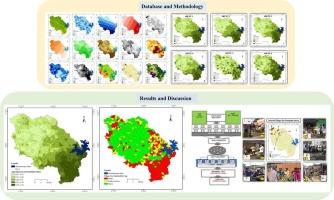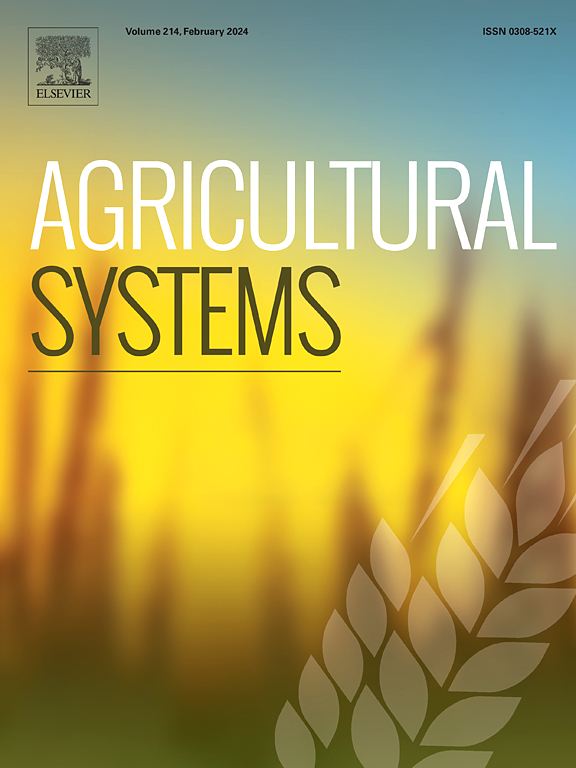在印度东部缺水地区综合考虑农田适宜性和农民对作物选择的看法
IF 6.1
1区 农林科学
Q1 AGRICULTURE, MULTIDISCIPLINARY
引用次数: 0
摘要
背景选择种植作物的理想依据是特定地块是否适合种植特定作物。这是一个多标准问题,与地形、气候和土壤等一系列自然条件变量有关。然而,在印度这样一个国家,农业通常以传统和自给自足为基础,农民对作物的选择通常会受到众多因素的影响,因此,可能无法仅用农田适宜性的空间变化来解释。本研究选择了印度东部的库马里河流域。基本方法包括提取有关地形、气候和土壤等条件因素的系统信息。通过模糊成员函数对不同参数进行归一化处理后,对这些条件栅格采用经过改进的主成分分析法,得出所研究流域的农田适宜性指数。此外,还采用布尔逻辑法考虑了水稻和玉米的特定作物适宜性。 结果与结论据观察,库马里盆地的下域与上域和中域相比土地适宜性更高,这种分布背后最重要的因素包括坡度、潜在蒸散量和土壤肥力。特定作物的土地适宜性表明,总体而言,盆地内玉米的适宜性高于水稻,但下域除外,那里更适合种植水稻。然而,对当地农民看法的研究表明,尽管他们意识到这一事实,但他们更喜欢种植水稻而不是玉米,并且更倾向于种植水稻。他们提出的主要原因包括该地区对水稻的需求量大,以及玉米没有最低支持价格。这项研究可能是通过对农民进行实地认知调查来证实农业用地适宜性分析的一个实例,预计将有助于了解印度这一地区作物选择的复杂性。本文章由计算机程序翻译,如有差异,请以英文原文为准。

Integrating agricultural land suitability and farmers' perception on crop selection in a water-stressed region of eastern India
CONTEXT
The choice of crops for cultivation should be ideally based on the appropriateness of a specific parcel of land for a particular crop. This is a multi-criteria problem associated with a host of natural conditioning variables including topography, climate and pedology. However, in a country like India, where agriculture is often traditional and subsistence-based, the farmers' choice of crop selection is usually influenced by numerous factors and therefore, may not be explained solely by the spatial variation in the agricultural land suitability.
OBJECTIVE
This study is an attempt to understand the intricacies involved in the farmers' selection of crops by integrating the dual aspects of agricultural land suitability and the farmers' understanding of the land. The Kumari River Basin in eastern India has been selected for this study. This area is characterized by acute scarcity of water.
METHODS
The basic methodology involved extracting systematic information on conditional factors such as topography, climate and soil. After normalizing different parameters by the Fuzzy Membership Function, a reiterative Principal Component Analysis modified Analytical Hierarchy Process was applied to these conditional rasters to derive an index of agricultural land suitability of the studied basin. Furthermore, the crop-specific suitability of paddy and maize was also considered by employing the Boolean Logic.
RESULTS AND CONCLUSIONS
It is observed that the lower domain of the Kumari Basin is characterized by greater land suitability as compared to the upper and middle domains and the most important factors behind this distribution include slope, potential evapotranspiration and soil fertility. Crop-specific land suitability suggests that, by and large, the suitability of maize is greater than that of paddy in the basin, except for the lower domain where paddy is more suitable to cultivate. However, a study of the perception of the local farmers reveals that although they are aware of this fact, they prefer paddy over maize and are more inclined towards cultivating paddy. The chief reasons cited by them include the high demand for paddy in the area and the absence of a Minimum Support Price for maize.
SIGNIFICANCE
This study is possibly an instance where the agricultural land suitability analysis has been substantiated by a field-based perception survey of the farmers which is expected to help in understanding the complexities of crop selection in this part of India.
求助全文
通过发布文献求助,成功后即可免费获取论文全文。
去求助
来源期刊

Agricultural Systems
农林科学-农业综合
CiteScore
13.30
自引率
7.60%
发文量
174
审稿时长
30 days
期刊介绍:
Agricultural Systems is an international journal that deals with interactions - among the components of agricultural systems, among hierarchical levels of agricultural systems, between agricultural and other land use systems, and between agricultural systems and their natural, social and economic environments.
The scope includes the development and application of systems analysis methodologies in the following areas:
Systems approaches in the sustainable intensification of agriculture; pathways for sustainable intensification; crop-livestock integration; farm-level resource allocation; quantification of benefits and trade-offs at farm to landscape levels; integrative, participatory and dynamic modelling approaches for qualitative and quantitative assessments of agricultural systems and decision making;
The interactions between agricultural and non-agricultural landscapes; the multiple services of agricultural systems; food security and the environment;
Global change and adaptation science; transformational adaptations as driven by changes in climate, policy, values and attitudes influencing the design of farming systems;
Development and application of farming systems design tools and methods for impact, scenario and case study analysis; managing the complexities of dynamic agricultural systems; innovation systems and multi stakeholder arrangements that support or promote change and (or) inform policy decisions.
 求助内容:
求助内容: 应助结果提醒方式:
应助结果提醒方式:


